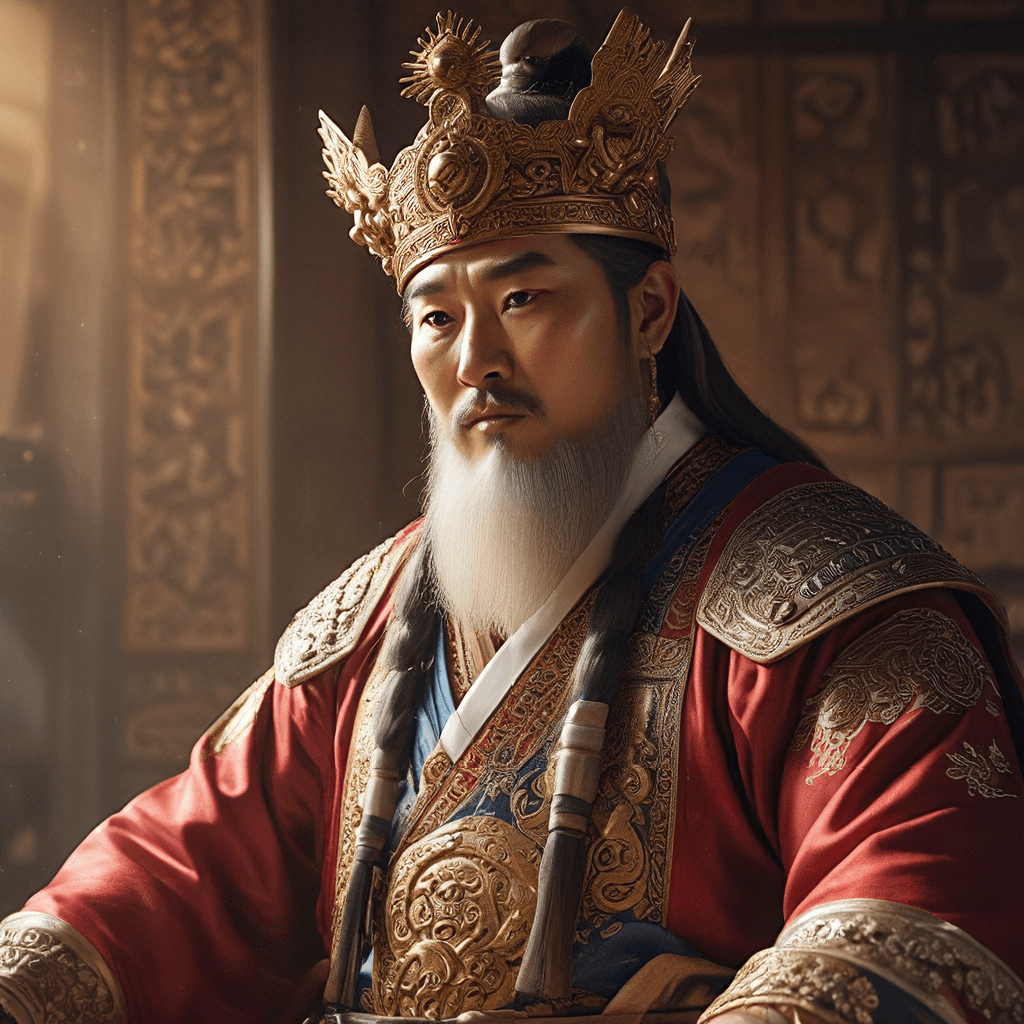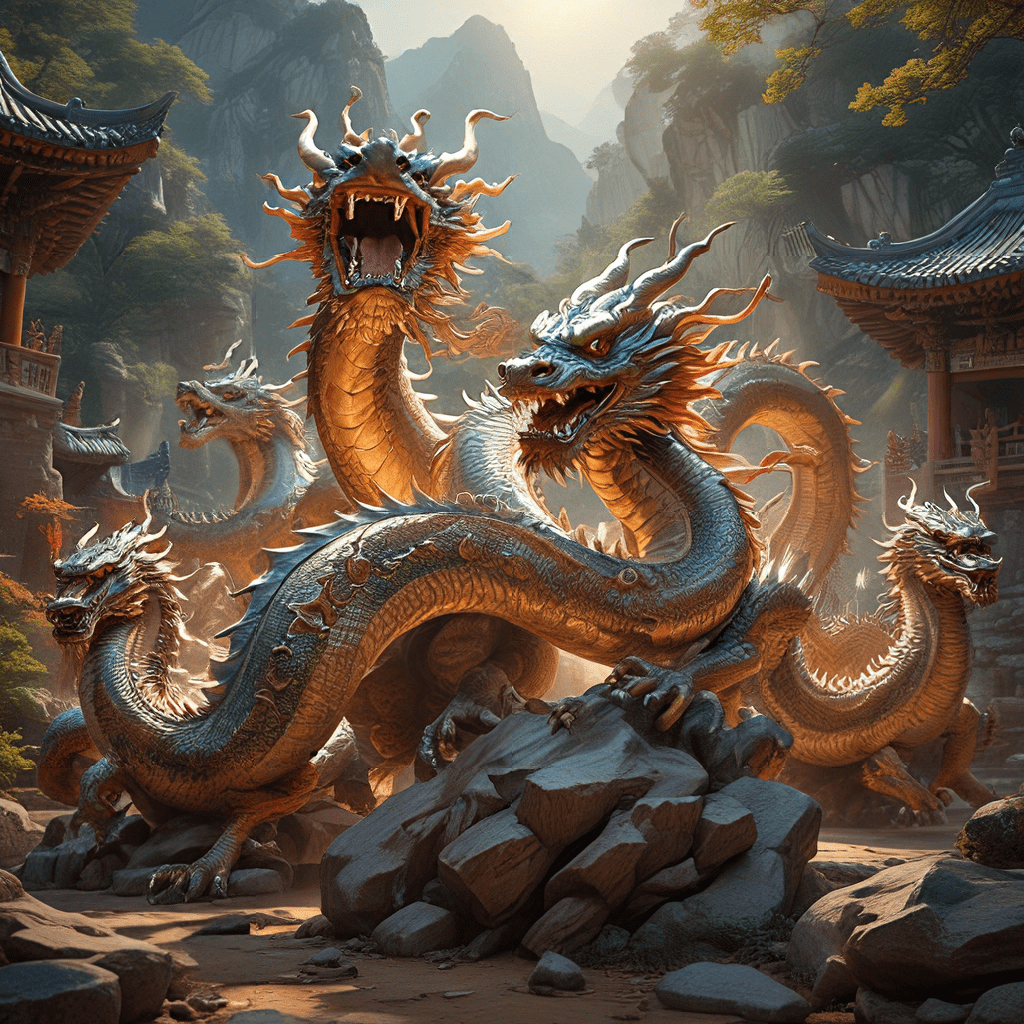The Legend of King Jinheung of Silla in Korean History
King Jinheung (532-576 AD) stands tall as one of the most celebrated figures in Korean history. He was the 24th ruler of the Silla kingdom and is widely credited with unifying the Korean peninsula under Silla's rule. His reign marked a pivotal moment in Korean history, laying the foundation for a unified and powerful nation. While much of Jinheung's life is shrouded in myth and legend, his accomplishments are undeniable.
The Mythological Origins of King Jinheung: A Divine Mandate
According to Silla mythology, King Jinheung's lineage traced back to the mythical founder of Silla, Hyeokgeose, who was said to be the son of the divine being, Heaven, and a bear woman. This divine mandate, passed down through generations, gave the Silla rulers a sense of legitimacy and authority. Jinheung's own birth was also imbued with mythical elements. He was said to have been born on a day with a bright, auspicious rainbow. Legends also claim that he was born with an unusual mark on his back, a symbol of divine favor.
These stories, passed down through generations in Silla, helped solidify Jinheung's image as a chosen ruler, destined to unify the Korean peninsula. The mythical origins of King Jinheung not only strengthened his claim to the throne but also played a significant role in his later success. It fueled his ambition and provided a powerful narrative for his people.
The Early Life of King Jinheung: From Prince to Ruler
King Jinheung's early life was marked by both stability and struggle. He was born to King Beopheung, a powerful and ambitious ruler who was determined to expand Silla's territory. Jinheung's education was steeped in Silla's traditions, history, and military strategies. As a young prince, he was deeply involved in the inner workings of the court, learning the art of governance and diplomacy.
The path to the throne, however, wasn't smooth. Jinheung faced challenges in his youth, including internal power struggles and threats from rival kingdoms. His father's death in 540 AD left him facing a realm still embroiled in conflict. Despite these challenges, Jinheung proved to be a skilled and decisive leader. He skillfully navigated the political landscape, securing his claim to the throne and consolidating his power.
Unification of the Korean Peninsula: King Jinheung’s Military Campaigns
King Jinheung's reign was marked by a series of military campaigns that ultimately led to the unification of the Korean peninsula. He was a brilliant strategist and a courageous warrior, leading his armies to victory against formidable opponents. His military campaigns targeted the Baekje and Goguryeo kingdoms, the two main rivals to Silla's dominance.
One of his most notable achievements was the defeat of Baekje at the Battle of Sabyong in 551 AD. This victory significantly weakened Baekje's power, allowing Silla to expand its territory southwards. In 553 AD, Jinheung took control of the important strategic city of Hanseong, the capital of Baekje. This victory weakened Baekje's grip on the Korean peninsula and paved the way for Silla's ultimate triumph.
The Silla Kingdom under King Jinheung: Expansion and Consolidation
King Jinheung's reign saw a period of rapid expansion and consolidation for the Silla kingdom. He was a shrewd administrator and an effective reformer, implementing policies to strengthen the Silla kingdom and lay the foundation for a unified Korea. He introduced a new system of governance, strengthening the central government and reducing the power of local clans. He reorganized the Silla military, creating a more efficient and powerful fighting force.
One of his key achievements was the establishment of a strong infrastructure system. He constructed roads, bridges, and other public works to connect different parts of the Silla kingdom, facilitating trade, communication, and the movement of troops. This infrastructure not only improved Silla's internal affairs but also played a crucial role in unifying the Korean peninsula.
The Legacy of King Jinheung: A Founder of Korean National Identity
King Jinheung is remembered as the founder of unified Silla and a key figure in the development of Korean national identity. The Silla kingdom, under his rule, became a cultural powerhouse, with significant advancements in art, literature, and philosophy. He is credited with fostering a sense of unity and shared identity among the Korean people.
Jinheung's legacy extended beyond his military achievements and administrative reforms. He is revered for his wisdom, courage, and commitment to his people. His reign is considered a golden age in Silla's history, a time of prosperity, progress, and cultural flourishing. Although he ruled for only 16 years, his impact on Korea was profound. His legacy continues to inspire and shape the Korean nation even today.
The Historical Reality of King Jinheung: Separating Fact from Fiction
While many stories about King Jinheung are shrouded in legend, historians have unearthed a wealth of information about his reign. His reign was a pivotal time in Korean history, marked by political maneuvering, military expansion, and social change. While he may not have been born with a rainbow or a divine mark, his achievements were remarkable.
Historians believe that Jinheung was a skilled leader who skillfully used military tactics and diplomatic strategies to secure Silla's power. He was a pragmatic ruler, adept at forming alliances, fostering trade, and promoting cultural exchange. He understood the importance of building alliances and expanding Silla's influence beyond its border. These diplomatic efforts were as crucial to his success as his military conquests.
His leadership during a tumultuous time in Korean history is undeniable. While legends may embellish his personal life, his impact on the political landscape is well-documented. The historical reality of Jinheung is a testament to his strategic brilliance and his unwavering dedication to unifying the Korean peninsula.
The Role of Buddhism in Silla’s Rise: King Jinheung’s Patronage
Buddhism played a profound role in the Silla kingdom's rise to power, and King Jinheung was a key figure in this transformation. He was a staunch patron of Buddhism, recognizing its potential to unite the Silla people and inspire them to achieve greater things. He welcomed Buddhist monks and scholars to Silla, fostering the development of Buddhist temples and monasteries. He established the first Buddhist temple in Silla, the Bulguksa Temple, which became a center of Buddhist learning and worship. This patronage helped to solidify the influence of Buddhism in Silla society, enhancing the kingdom's cultural landscape.
The adoption of Buddhism had a profound influence on Silla's cultural development. It promoted a unified system of values and beliefs, fostering harmony and social stability. It also contributed to Silla's artistic and intellectual development, with the kingdom becoming a center of Buddhist art, literature, and philosophy.
Buddhism went beyond its religious influence, shaping Silla's political and social structures. It provided a moral framework for governance and fostered a sense of unity among the people, which was essential in the face of internal and external challenges. King Jinheung's patronage of Buddhism ultimately played a crucial role in Silla's unification of the Korean peninsula.
The Influence of Chinese Culture: King Jinheung’s Reforms
King Jinheung was also a keen student of Chinese culture, recognizing the importance of Chinese advancements in government, law, and administration. He implemented a number of reforms based on Chinese models, strengthening Silla's infrastructure and institutions.
He introduced a new system of government based on the Chinese model, consolidating power in the hands of the monarch and creating a more centralized administration. He also adopted the Chinese legal system, creating a code of laws that served as a foundation for Silla's justice system.
These Chinese influences played a significant role in Silla's development, helping the kingdom transform from a small regional state into a unified and powerful nation. They provided Silla with a blueprint for effective governance, administrative efficiency, and social order.
King Jinheung's adoption of Chinese cultural elements, while incorporating Silla's traditions, ultimately shaped the Silla civilization into a distinct and influential force in Korean history. He understood that absorbing valuable elements from other cultures could strengthen Silla's own identity and pave the way for its rise to dominance.
Theories on the Origins of Silla: The Role of the “Three Kingdoms” Period
Silla's origins are intertwined with the dynamic and often turbulent "Three Kingdoms" period in Korean history. During this period, Silla, Baekje, and Goguryeo engaged in a series of battles for dominance over the Korean peninsula. It was a time of constant warfare, shifting alliances, and cultural exchange.
The exact origins of Silla are debated by historians, with different theories proposed. However, it is widely accepted that Silla emerged from a small, independent state in the southeastern part of the peninsula. They gradually expanded their influence through strategic alliances, military campaigns, and a shrewd understanding of political dynamics.
The "Three Kingdoms" period was a crucible for Silla's development, shaping its political structure, military strategies, and cultural identity. It was in this period that Silla's resilience, adaptability, and leadership qualities were honed, ultimately leading to its unification of the Korean peninsula under King Jinheung.
The Legend of King Jinheung: A Symbol of Korean Resilience and Strength
In Korean history, King Jinheung remains a symbol of strength, resilience, and the unwavering spirit of the Korean people. He is celebrated as the leader who brought unity to a divided land, laying the foundation for a unified Korean nation. His legacy continues to inspire generations of Koreans, reminding them of their shared history and their capacity to overcome adversity.
Even today, King Jinheung's story resonates with Koreans. He is a reminder that even in the face of daunting challenges, determination and strategic thinking can lead to remarkable achievements. His story is a powerful reminder of the Korean people's ability to overcome obstacles and build a strong and unified nation.
FAQ
What are some of the key achievements of King Jinheung?
King Jinheung is credited with uniting the Korean peninsula under Silla's rule, defeating Baekje and Goguryeo, establishing a strong infrastructure system, and promoting Buddhism.
What are some of the legends surrounding King Jinheung?
Legends surrounding King Jinheung include a divine mandate, being born on a day with a bright rainbow, and having a divine mark on his back.
What was the role of Buddhism in Silla's rise to power?
King Jinheung was a patron of Buddhism, which played a significant role in unifying the Silla people and fostering a sense of harmony.
How did Chinese culture influence Silla during King Jinheung's reign?
King Jinheung adopted Chinese models for government, law, and administration, strengthening Silla's infrastructure and institutions.
How is King Jinheung remembered in Korean history?
King Jinheung is celebrated as a symbol of strength, resilience, and the unwavering spirit of the Korean people. He is revered as the leader who brought unity to a divided land.


